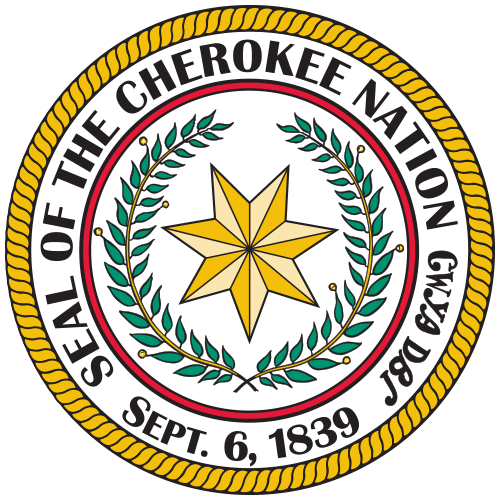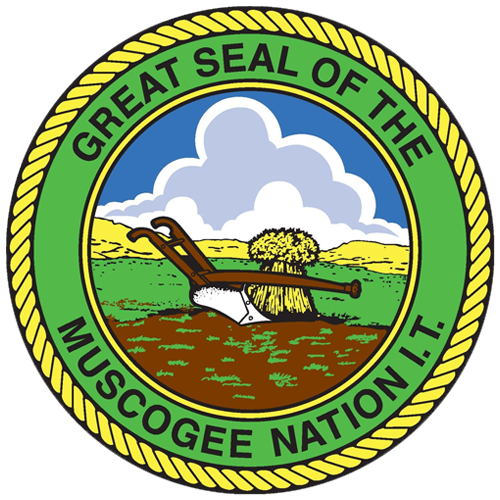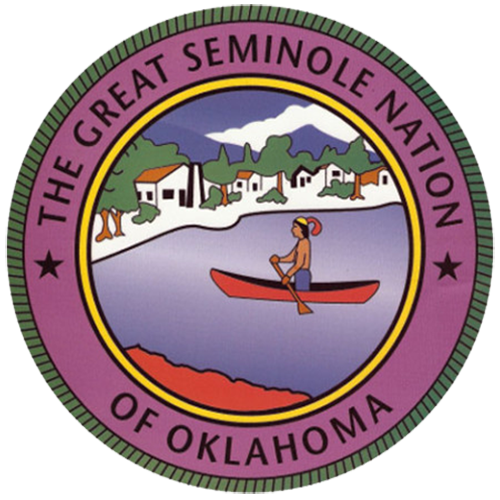




- Home
- Five Civilized Tribes
-
Council Documents
- Council Minutes
-
Resolutions
- Resolutions 1995
- Resolutions 1996
- Resolutions 1997
- Resolutions 1998
- Resolutions 1999
- Resolutions 2000
- Resolutions 2001
- Resolutions 2002
- Resolutions 2013
- Resolutions 2014
- Resolutions 2015
- Resolutions 2016
- Resolutions 2017
- Resolutions 2018
- Resolutions 2019
- Resolutions 2020
- Resolutions 2021
- Resolutions 2022
- Resolutions 2023
- Resolutions 2024
- Document Templates
Chapter Six
Chapter Six
Section One: 1990s
Thus, as the ITC entered the nineties, the Council had some of the same major considerations listed in previous decades: Welfare, health, housing, aging, education, land settlements, sovereignty, law enforcement, and taxation.
However, by 1990, the Five Civilized Tribes through their own efforts had become economically and politically more independent, and, therefore, they would demand a more active role in state and federal affairs.
The ITC unanimously stressed, for example, its continued support for an increase in funding of federally administered Indian housing programs. Along these lines, Governor Anoatubby of the Chickasaw Nation presented Resolution FY91-15 to the ITC “requesting the Department of Agriculture to amend its requirements whereby cities with 10,000 or more population be eligible to participate in the food distribution program.”
In 1991, Oklahoma members of a National Task Force on Aging met with Indian Health Service representatives to discuss the centralization of long-term health care. Since the Title V program of the National Indian Council on Aging has been beneficial to the elders of the tribal governments of Oklahoma, the ITC sustained a resolution: “Calling upon the Oklahoma congressional delegation to request additional positions to be allocated to the NICA for Oklahoma.” And, the effectiveness of the ITC’s intervention and support was observed when in 1991 state monies were appropriated and an Indian Desk was created to help administer new aging programs.
Regarding education, the ITC enacted a resolution presented by Principal Chief Wilma Mankiller on October 12, 1990, requesting: “That the Oklahoma State Regents for Higher Education support that American Indians belonging to Oklahoma Indian nations, regardless of their geographical residence, be granted in-state status for the purpose of tuition.” Determined “to advocate the preservation of high standards of educational excellence for students in Indian dormitory school programs, public schools and others,” the ITC resolved “to carry out the responsibility of leadership ··· in programs that give students a feeling of educational achievement.”
Section Two: Oklahoma’s House Bill 1017
To help accomplish their goals, the Council committed on January 11, 1991, that “the United States Secretary of Interior, the Honorable Manuel Lujan, do everything within his power and authority to ensure that Oklahoma, one of the most populous Indian states in the United States, will have Indian educational representation on the Advisory Committee to the White House Conference on Indian Education.” As a result of this intervention, the ITC was successful in having representatives selected to serve on the Advisory Committee to the White House Conference on Indian Education. The entire state’s delegation was comprised of 23 members. Additionally, in October 1991 the ITC unanimously committed its support for Oklahoma House Bill 1017, a bill establishing numerous reforms in education. Particularly, the ITC encouraged the inclusion of native language curricula in the public schools of Oklahoma.
Section Three: Land Settlements
Regarding land settlements, up-lifting news was disclosed at the January 1990 ITC meeting that the Bureau of Land Management (BLM) would not charge a 20 percent administrative fee for the survey work of the Arkansas Riverbed and that the work would be made an immediate priority. The 1970 Supreme Court ruling that the above mentioned tribes were indeed owners of the resource-rich 96-mile Arkansas Riverbed had become dampened by the requirement that the BIA had to order surveys of the area to properly apportion the land. After 19 years, only 789 of the 22,000 riverbed acres had been surveyed by the BIA; and, the involved tribes estimated that the delay had cost $100 million in revenues since the natural resources of the Arkansas Riverbed were not utilized. The Council praised the efforts of Chickasaw Governor Bill Anoatubby, Cherokee Chief Wilma Mankiller, and Choctaw Chief Hollis Roberts, “who had tried everything possible to get completion of the project on its way.” With the project rejuvenated, the BLM estimated to have the survey 90 percent completed by 1993.
Also cheering was the news from Jerry Haney, Chief of the Seminole Tribe, who related to the Council that the Florida Judgment Fund Award between the Florida and the Oklahoma Seminoles had been decided after a thirteen-year struggle; and, the Oklahoma tribe would receive 75 percent of the appropriated sum of $50 million. Chief Haney indicated that health care, education, economic development, programs for the elderly, and land acquisition would receive priority in using the acquired money.
To further protect the sacredness of ancestral remains, in July 1990 the ITC supported three proposed bills: the Native American Burial Sites Preservation Act of 1989; H.R. Bill 1646, the Native American Grave and Burial Protection Act; and H.R. Bill 5237, the native American Grave Protection and Repatriation Act.
Meanwhile, the ITC was heartened by the two-day consultation visit of Smithsonian Institute Under Secretary Dean Anderson to “gain input from area tribes on the creation of a new National Museum of the American Indian. The legislation calling for the construction of the new museum building to be situated at the foot of Capitol Hill, Washington, D.C., was signed by President George A. Bush in November 1989.
Expressing the ITC’s sentiments, Governor Bill Anoatubby said, “What we would like to see in this new museum is the achievement of a better understanding of the American Indian in history, in culture, in religion, and in contributions made.”
Of equal importance in 1991 the ITC’s proposal to review The Act of August 4, 1947. This act referred to laws that govern restricted lands, and the ITC decided that revision of the Act was needed to define problems and to break the program down into the following six basic categories: history/land administration and explanation, problems and current methods of administration, alternatives to status quo, priorities of recommendations, justification for change, and actual legislation. The ITC declared that it was most urgent hat a method be developed for the preservation of a land base to the greatest extent possible. Subsequently, the Council decreed that an inventory of land in restricted status would have to be established and a roster of original owners and their legally entitled heirs developed.
Similarly, for the benefit of those over age fifty-five, at the October 12, 1991, ITC meeting, Governor Bill Anoatubby introduced Resolution FY91-23 supporting S.B. 754 that would exempt $4,000 income derived from trust or restricted Indian land held by an individual when determining eligibility for federal assistance. Also, Governor Anoatubby declared that in order to prevent discrimination, the Council believed that restricted lands should be considered a life estate.
Section Four: Sovereignty
Connected to the issue of sovereignty, the ITC confirmed the important following resolution on October 12, 1990: “WHEREAS, in the practice of relations between governments, it is the international tradition and indeed rightly so, hat the executive levels of each government deal directly and solely with one another and do not interfere or meddle with the constitutional inner workings of multiple-branch governments, and NOW, THEREFORE, BE IT RESOLVED, that the Inter-Tribal Council of the Five Civilized Tribes supports, condones, and strongly recommends that all international relations, especially including those between the governments which represent the different Indian nations and the government of the United States of America, be made strictly on executive department-to-executive department levels.” Similarly, the same was true for the next levels of government.
Further protecting the sovereign powers of tribal government the ITC vehemently opposed Senator Orrin Hatch’s attempt to amend the Indian Civil Rights Act of 1968, since it would “allow federal courts to have final authority to tell an Indian tribe what its customs are and what it tribal laws mean.” Next, to attack the issue of law enforcement, the ITC accepted a resolution on October 11, 1991, which clearly outlined the perimeters of jurisdiction in a self-governed tribe thusly: “WHEREAS, THE united States Supreme Court has decided that, without specific authority granted by the United States Congress, Indian tribal courts do not have jurisdiction over nonmember Indians in criminal cases, thereby creating a serious jurisdictional void; and WHEREAS, the U.S. Congress has pending before it legislation to make permanent the authority granted by the Indian Civil Rights Act of 1968, as amended by Public Law 101-511, for Indian tribal courts to exercise criminal jurisdiction over all Indians ··· NO W, THEREFORE BE IT RESOLVED, that the Inter-Tribal Council of the Five Civilized Tribes supports a permanent resolution of this matter which will allow Indian nations and tribes the authority to exercise criminal jurisdiction consistent with self-government.”
The ITC also asserted its insistence on government-to-government relationship to federal policy when the Council decreed that “the tribes were not recognized as “co-managers of the nation’s fisheries and wildlife resources in federal fish and wildlife acts.” To correct the situation, the Council resolved: “That the Inter-Tribal Council of the Five Civilized Tribes ··· supports the development of a Native American Fish & Wildlife Enhancement Act through direct contact by letter of support to congressional representatives in Washington, D.C., and through direct testimony at congressional oversight hearings on this issue.”
The issue of tribal sovereignty further became a major concern in 1994 when a dispute over state taxation of Indian smokeshops erupted once more. Actually, the case began in 1987 when the Oklahoma Tax Commission assessed the Citizen Band Potawatomi Tribe $2.7 million in back taxes, penalties, and interest for cigarettes sold at tribal smokeshops between 1982 and 1986. When the Shawnee-based tribe filed suit against the Oklahoma Tax Commission, the latter filed a counter-suit. Eventually, the ruling of the U.S. District Court barred the Commission from collecting back taxes, but agreed that tribes should in the future collect taxes from nonmembers of the tribe.
When the Tribe appealed to the Tenth Circuit Court of Appeals in Denver, the suit stressed that since the Tribe had federal immunity to lawsuits, the U.S. District Court had ruled on an illegal lawsuit. Agreeing with the Tribe, the Tenth Circuit Court ruled against the Tax Commission and recommended that he Supreme Court hear the case. In a brief filed on the side of the Tribe, the ITC declared, “The case threatens the very existence of tribal government” and “could reduce tribes to mere social organizations completely under state domination.”
At the last ITC meeting in 1991, a farewell dinner was given for Chief Claude Cox, of the Muscogee Nation and the ITC for the past 20 years. That night, Choctaw Chief Hollis E. Roberts, Chickasaw Governor Bill Anoatubby, Seminol Chief Jerry Haney, Cherokee Chief Wilma P. Mankiller, and Sac and Fox Chief Elmer Manatowa were delighted to express their gratitude to Claude Cox for his assistance over the years. Certainly, the 300 friends who gathered to wish the long-time Chief farewell, “were visibly moved by his ever-present counsel.”
Another farewell in 1991 was bidden to W.E. (Dode) McIntosh, Chief of the Muscogee Nation from 1961 to 1971. Chief McIntosh passed away August 28, 1991. Remarkably, McIntosh was the fourth member of his family to assume the position as Principal Chief of the Muscogee Nation. During his enture, he distinguished himself as an important Indian leader on both the national and state levels.
As the decade of the 1990s began, the Inter-Tribal Council, directed by its new president, Chief Jerry Haney of the Seminole Nation, was confronted by many issues-such as the implementation of courts and law enforcement, continuing attacks on sovereignty, and enhanced development of the Five Tribes’ economies. Of particular interest to the ITC, however, was one very important development, the realignment of the Bureau of Indian Affairs. Determined not to participate “unless the tribal leadership of the Five Civilized Tribes was involved,” the Council was “very pleased when Gary Breshears of the Muscogee Nation and Greg Pyle, Assistant Chief of the Choctaw nation, were named to the National Advisory Task Force to realign the BIA.
With the hope for an effective reorganization of the BIA inspiring their efforts, the ITC, building on its outstanding forty years of service to the citizenry of the Five Civilized Tribes, remains dedicated to its democratic task.
The ITC may best be measured in the words of the former Area Director of the Muskogee Area Office, Virgil N. Harrington, who related:
- ··· The Inter-Tribal Council represents unity and strength in striving to accomplish everything possible for improvement of the social and economic conditions of the Indian people ··· its leaders are considered to be the most learned and experienced of any in the United States ··· this council wields much influence at the State and National levels in Indian Affairs.